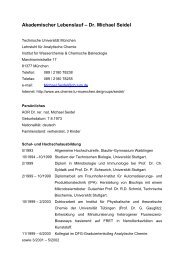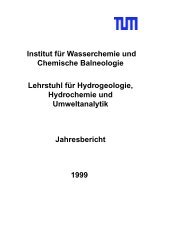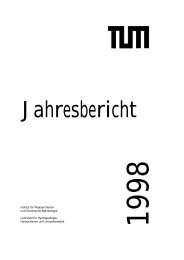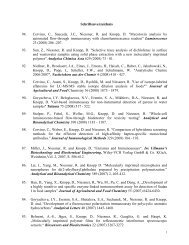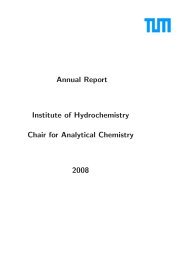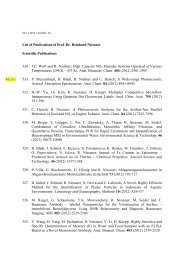IWC Annual Report 2003 - Institut für Wasserchemie und chemische ...
IWC Annual Report 2003 - Institut für Wasserchemie und chemische ...
IWC Annual Report 2003 - Institut für Wasserchemie und chemische ...
You also want an ePaper? Increase the reach of your titles
YUMPU automatically turns print PDFs into web optimized ePapers that Google loves.
1.1.4 Statistical Methods for the Assessment of Leachate Concentrations at the<br />
Point of Compliance<br />
F<strong>und</strong>ing: BMBF 02WP0175<br />
In order to protect the gro<strong>und</strong>water against pollution from contaminated sites, the<br />
German Guideline on Soil Protection stipulates, that the source strength of contaminants<br />
(Quellstärke) must be investigated prior to the deposition of partly hazardous<br />
material such as bottom ash from municipal solid waste incinerators.<br />
With respect to the heavy metal content of the bottom<br />
ash, it is important to determine conclusions to the<br />
environmental impact of the bottom ash material. Several<br />
authors have described a dependency of heavy metal<br />
concentration from the pH value and the storage time.<br />
Because bottom ash is often used in road construction,<br />
it is important to assess the mobility of heavy metals in<br />
contact with water <strong>und</strong>er different conditions. In order to<br />
describe the potential risk of a bottom ash material transferred<br />
into nature, it is necessary to find a proper way of<br />
extraction describing the way of leaching <strong>und</strong>er natural<br />
conditions.<br />
In the current project we could show by statistical methods (multivariate regression,<br />
factor analysis, clustering), that the heavy metal concentration in the leachate from<br />
28 different incineration plants all over Germany is neither influenced by any technical<br />
parameter of the incineration plant nor by the waste composition and amount. In toto,<br />
bottom ash can be described as a rather homogeneous material. There is statistical<br />
evidence that the heavy metal concentrations in three different bottom ash disposals<br />
can be approximated with the concentration in the leachate from the DEV-S4 extraction<br />
test performed with bottom ash, stored for one year prior to the test. The results<br />
from the other elution tests such as the soil saturation extract, the Swiss elution test as<br />
well as the DEV-S4 with ‘younger´ bottom ashes seems to overestimate the dissolvable<br />
heavy metal content in the bottom ash material.<br />
Available data suggests an exponential decrease of leachate concentrations with time,<br />
which is very similar to the observed exothermal reactions in the MSWI bottom ash<br />
material. This knowledge gives us the possibility to predict the heavy metal concentration<br />
in the S4 extract at any time of bottom ash aging. The <strong>und</strong>erlying hypothesis<br />
is, that the carbonization of the bottom ash, which was measured independently, not<br />
only reduces the availability of reactive phases in the bottom ash, thus leading to a<br />
decrease of the heat production. These coatings also reduce the availability of the<br />
metal ions, thus leading to reduced leachate concentrations.<br />
(R. Biber)<br />
C, mg/L<br />
1e−04 1e−02 1e+00 1e+02<br />
As Cd Cr CrVI Cu Hg Ni Pb Zn<br />
n=276 n=162 n=394 n=94 n=464 n=102 n=422 n=490 n=488<br />
7



